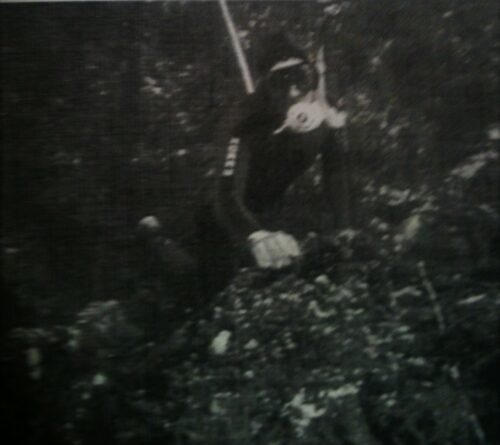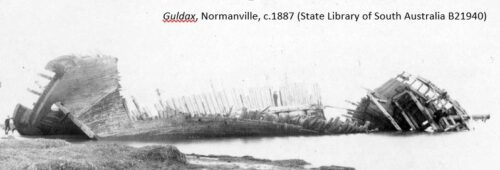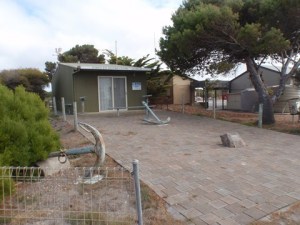A couple of large anchors were found at Normanville between the late 1960s and late 1970s. Either of these two anchors may have been from the wreck of the Guldax, a 556-ton wooden barque built in Norway in 1878.
In October 2018, I wrote at https://stevesshipwrecksite.blogspot.com/2018/10/the-wreck-of-guldax.html , “The wooden barque Guldax was wrecked (due to a captain’s error?) whilst she was anchored in Gulf St Vincent, waiting to pull into port during early September 1887. The 556-ton Guldax was 11 years old at the time. She had been built at Lillesand, a municipality in Aust-Agden county, Norway by OP Knudsens Verft for Krogh & Henschien in 1878. She had left Gottenburg, Sweden, on 17th May 1887, bound for Melbourne. On 2nd September 1887, she was under sail just off Normanville between the jetty and Gorge Creek. It is said that her crew had underestimated the nature of the reefs in the area. She ran aground about ½ mile from shore, nearly one mile south-west of the Normanville jetty.”
Further, “The assistant harbourmaster at Normanville beach reported by telegram to the marine board that the Guldax had anchored very close inshore and that she was probably unable to get clear unless the wind turned west. She was said to be making no signals and was deeply laden. A later telegram stated, “barque ashore, two boats trying to land, all hands appear to have left her, sea running high”. Her bow was firmly stuck on a reef and the crew abandoned ship.
“The Port Adelaide Tug Company sent the steamer Yatala to her aid. With 11 ft of water in her hold within a week, the Guldax was lying on her side. One week later, she drifted closer to shore. Her structure was severely damaged. The wreck was heavily salvaged at the time.”
Society member, David Muirhead helped his father to recover an anchor at Normanville in the late 1960s (“around 1968, 1969, maybe earlier, say 1967”). According to David, it was “Directly off the beach level, with our shack, give or take a few metres. It was about 70-100 metres offshore in a depth of about 4 metres, perhaps less.

“Rob Kirk and I snorkelled to attach (a line – “chain, or steel cables, or thick rope”) to the 3 main points of the anchor which lay roughly flat on the limestone bottom. My dad supervised from our mirror dinghy (small wooden sailing boat…but we rowed it, no mast or sails on the day in question). He then connected a pulley rope system with two (or maybe 4??) empty 44 gallon drums for flotation (the drums were firmly bound together side by side before they were towed out to the anchor which we’d prepared the day before).
“Then on the Sunday morning when there were plenty of fit men enjoying the nice weather with their families in tents on the beach, dad went around and recruited about 10 volunteers to help us pull the rope shore-ward in unison. Unfortunately the drums provided barely enough flotation for the pulley system to work properly.
“The idea was that the anchor would be lifted vertically off the bottom before being floated to the beach without even scraping the bottom. But after the anchor pulled free of the limestone (which it was firmly fixed to, being heavily rusted as you would expect and with some very solid guage heavily corroded chain links at the shank end adding to the stubborn refusal to ‘let go of the bottom ‘) it was so heavy and the water so shallow at low tide that it bumped and hopped along the bottom and that’s what probably caused one of the 2 flukes to break off.
“The obvious solution would have been for dad to add more flotation drums and try again another day, but he didn’t have time to do anything like that. So we at least managed to drag it ashore while there were still some volunteers lingering to help lift it onto dad’s little wooden trailer which he’d rescued from the local rubbish dump years earlier (he’d greased the axle patched the flat tyres and wired it for night driving, etc.., and I helped paint it dark green).
“Towed the trailer to the shack, secured the anchor firmly and drove back to Adelaide. It was the sort of engineering challenge that my dad loved, but he admitted that he had not put enough preparation into the job.
“He also found that his prearranged contact person in a Port Adelaide maritime museum (then Port Adelaide Nautical Museum?) storage area became less interested once he knew that one fluke was missing. So I think it was just too much bother to follow up thoroughly and dad was working full time anyway and this little project was not ever going to generate any money.
“But I don’t know what ship the Normanville anchor was from. Guldax maybe, but various other possibilities exist, and I guess it can’t even be assumed that it is from a wreck event…could have been stuck in a ledge and let go when a ship had to leave in a hurry due weather deterioration, etc..
“Most such abandoned anchors would be retrieved later because they were valuable, but not all. However I do think that anchor was from an actual wreck event.”
Members of the then Society for Underwater Historical Research (SUHR) were reportedly searching for the wreck of the Guldax in 1977. In 1979, Stan Spencely reported having found what he thought was the anchor from the Guldax.

The SUHR (now the South Australian Archaeology Society) was planning to do a new site inspection (re-inspection) of the Guldax in early 1983. I haven’t found any further record of what may have transpired other than The April/June 2001 “Soundings” newsletter reporting that a recent exposed boiler at Normanville may possibly have been from the Guldax.
Peter Christopher, Life Member for the SUHR, wrote in “South Australian Shipwrecks – A Data Base 1802-1989” that the SUHR had conducted a survey of the Guldax.
I found this image of the Guldax in an SUHR publication or newsletter: –

According to “Shipwrecks in South Australia, Book 2, 1876-1899” by Ronald Parsons, “the ship wa thrown ashore between the Normanville jetty and Gorge creek. ….. the vessel that had been swept by heavy seas all night. ….. another gale sprang up on September 21. This drove the wreck further ashore ….. by Oct. 8 all the cargo had been salvaged although the ship was in a mess as it had been necessary to cut away almost all her beams to get at the timber.”

I don’t know what came of the anchor reportedly found by Stan Spencely in the late 1970s. Nor do I know what came of the anchor retrieved by David Muirhead for his father in the late 1960s. One fluke had broken off of the anchor and the Port Adelaide Nautical Museum may not have been very interested in it.


I don’t think the anchor dad retrieved would be from the Guldax, based on the stated location of the foundering and salvage. Sounds like a fair distance south of the jetty and ‘our ‘ anchor was about 100 metres north of the jetty. And FWIW there * is/was (see below*)an old and quite big ship’s boiler on the beach about 200 to 250 metres south of the jetty (*probably was…I think it was removed decades ago by request of Yankalilla District Council because it was a hazard for vehicles, equestrians and pedestrians on the beach. Sometimes it was completely buried under sand, mid beach/roughly mid littoral zone, but sometimes it would be partly exposed following weather events).
What shipwreck it was from I’ve no idea but presumably not the Guldax either. Not a steamer and any such thing would have been salvaged anyway).
[…] publication of my article Large Anchors Found at Normanville may have been a little hasty. It did, however, lead to discussions with local Normanville residents […]
[…] information has come to hand since I wrote Large Anchors Found at Normanville and More About the Shipwrecks at […]